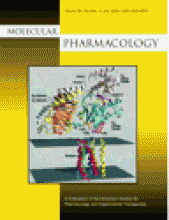Abstract
There are few antagonists selective for subtypes of the several P2X receptors, but these are needed to identify the receptors expressed on native cells and tissues. In particular, P2X4 and P2X7 receptor subunits are colocalized on immune, epithelial, and exocrine gland cells, but both are relatively insensitive to suramin and pyridoxal-5-phosphate-6-azo-2′,4′-disulfonic acid derivative. In this article, we show that Coomassie Brilliant Blue G selectively inhibits P2X7 receptors with nanomolar affinity. We measured currents in response to P2X receptor activation in HEK293 cells heterologously expressing human or rat P2X1, P2X2, P2X3, P2X2/3, P2X4, P2X1/5, and P2X7 receptors. Brilliant Blue G produced a noncompetitive inhibition of rat and human P2X7 receptors with IC50 values of 10 and 200 nM, respectively. IC50 values for inhibition of the other receptors ranged from 2 to >30 μM; the rat and human P2X4 receptors showed IC50 values of >10 and 3.2 μM. Coomassie Blue G also blocked YO-PRO1 uptake and membrane blebbing, which are uniquely associated with activation of P2X7 receptors. Thus, Brilliant Blue G is at least 1000-fold more potent at rat P2X7 receptors than at rat P2X4 receptors.
Footnotes
- Received January 24, 2000.
- Accepted March 7, 2000.
-
Prof. Annmarie Surprenan, Institute of Molecular Physiology, Department Biomedical Science, Alfred Denny Bldg., Western Bank, University of Sheffield, Sheffield S10 2TN England. E-mail:a.surprenant{at}sheffield.ac.uk
-
This work was supported by The Wellcome Trust (A.S.) and AstraZeneca (R.A.N.).
- The American Society for Pharmacology and Experimental Therapeutics
MolPharm articles become freely available 12 months after publication, and remain freely available for 5 years.Non-open access articles that fall outside this five year window are available only to institutional subscribers and current ASPET members, or through the article purchase feature at the bottom of the page.
|






